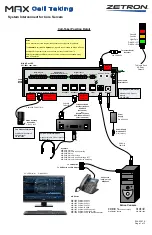
9
Instruction Booklet
IB48088
Effective July 2021
Instructions for Eaton’s 7.2 kV Ampgard AR
(arc resistant motor control center)
(Compliant to IEEE C37.20.7-2017)
EATON
www.eaton.com
Section 2: Receiving, handling, and storing
2.1 Receiving
The equipment is shipped assembled in shipping sections/splits
without ducts and plenums installed. Depending on the length of
the lineup, it may be necessary to ship the equipment in several
shipping sections/splits to facilitate handling. Each shipping section/
split is shipped bolted to a wooden skid and covered with protective
material.
Only accept items from shipping carrier if all the items described on
the packing list have been received.
If the equipment has been damaged, file a claim as soon as possible
with the carrier and notify the nearest Eaton representative.
2.2 Handling
An Ampgard AR is equipped with insulated components for medium
voltage and must be protected against damage during handling.
The controller should always remain upright. Exercise extreme care
during any movement and placement operations to prevent dropping
or unintentional rolling or tipping. The preferred method of lifting and
maneuvering the shipping sections/splits into their final position is
with an overhead crane. Lifting plates are bolted to the top of each
shipping section. Attach a four-leg sling with hooks to all four lifting
plates to lift or move the sections. Do not allow the angle between
the lifting cables and vertical to exceed 45 degrees.
Each controller is properly adjusted at the factory before shipment.
However, vibration and mechanical stresses imposed by transit and
installation can adversely affect mechanical interlocks. Therefore, a
final inspection is essential before energizing.
Figure 11. Location of lifting plates.
After the section has been moved into installation position, remove
the hooks and lifting plates. Discard the lifting plates and hardware.
Refer to
for the approximate weights of the various
AMPGARD equipment configurations. The weight may differ
depending on the option(s) picked.
Table 4. Typical section weights.
Equipment
type
Width
Main bus
rating
Structure
weight
(Plenum
weight not
included)
Plenum weight
in. (mm)
amperes lbs (kg)
lbs (kg)
400 A starter
(2-high)
36 (914)
1000
1829 (830)
159 (72)
(Mid. line-up)
219 (99)
(End line-up)
1200
1847 (838)
2000
1881 (853)
3000
1946 (883)
800 A starter
(1-high)
36 (914)
1000
1943 (881)
1200
1974 (895)
2000
2008 (911)
3000
2073 (940)
Incoming line
18 (457)
1000
660 (299)
79 (36)
(Mid. line-up)
139 (63)
(End line-up)
1200
668 (303)
2000
692 (314)
3000
744 (337)
24 (610)
1000
782 (355)
105 (48)
(Mid. line-up)
165 (75)
(End line-up)
1200
790 (358)
2000
814 (369)
3000
862 (391)
36 (914)
1000
1087 (493)
159 (72)
(Mid. line-up)
219 (99)
(End line-up)
1200
1095 (497)
2000
1119 (508)
3000
1167 (529)
Exhaust duct per
1 in. (25 mm) of
length
1 (25)
-
-
2 (1)
Dual exhaust
manifold
18W x 31H x 72D
[457W x 787H x
1828D]
-
-
182 (83)
4 in. transition
section
4 (102)
-
162 (84)
25 (11)
2.3 Storing equipment
Ampgard equipment contains insulating materials, electrical
contacts, and operating mechanisms which must be protected
against dirt, moisture, dust, foreign materials, corrosive atmo-
spheres, and extreme temperature changes. If it is necessary to
store the equipment before installation, place the equipment indoor
on a true and level surface in order to reduce strain and distortion in
the equipment. Cover and keep it in a clean and dry location with
ample air circulation and heat to prevent condensation.
NOTICE
STORING THE EQUIPMENT OUTDOORS IN NOT RECOMMENDED.
Four lifting plates
(w/Ø 1.50 inch hole))










































